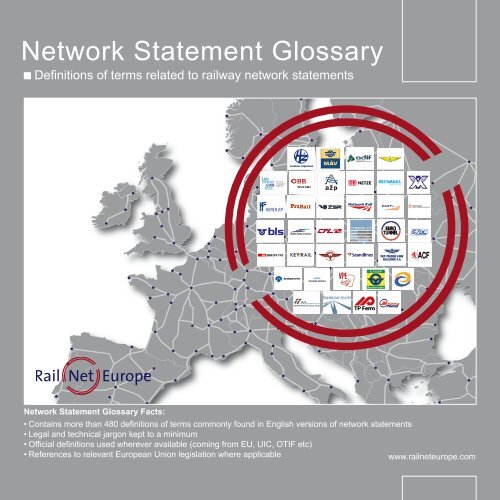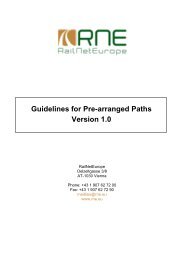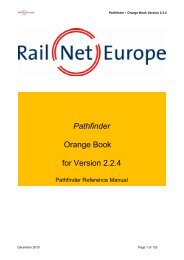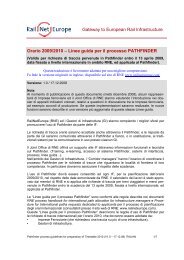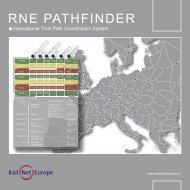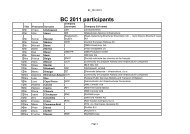Network Statement Glossary.pdf - RailNetEurope (RNE)
Network Statement Glossary.pdf - RailNetEurope (RNE)
Network Statement Glossary.pdf - RailNetEurope (RNE)
You also want an ePaper? Increase the reach of your titles
YUMPU automatically turns print PDFs into web optimized ePapers that Google loves.
<strong>Network</strong> <strong>Statement</strong> <strong>Glossary</strong><br />
Definitions of terms related to railway network statements<br />
<strong>Network</strong> <strong>Statement</strong> <strong>Glossary</strong> Facts:<br />
• Contains more than 480 definitions of terms commonly found in English versions of network statements<br />
• Legal and technical jargon kept to a minimum<br />
• Official definitions used wherever available (coming from EU, UIC, OTIF etc)<br />
• References to relevant European Union legislation where applicable<br />
www.railneteurope.com
A <strong>Glossary</strong> Dedicated to <strong>Network</strong> <strong>Statement</strong>s<br />
Under EU Directive 2001/14/EC (Art. 3) ‘The network statement shall be published no less than four months in advance of<br />
the deadline for requests for infrastructure capacity’; in practice this is December. <strong>Network</strong> statements are then translated<br />
into other national language(s) if necessary, and into English – the English translations are usually published in the first<br />
quarter of the following year. In May 2010, the <strong>RailNetEurope</strong> General Assembly made it mandatory to translate the main<br />
document in network statements into English.<br />
Why harmonise the terminology used in the English-language versions of network statements<br />
The use and interpretation of specialised terms often diverge from network to network across Europe – this can create<br />
confusion for readers. Hence there was a need to define terms that are commonly employed in the English-language versions<br />
of network statements and <strong>RNE</strong> created a new tool, a <strong>Glossary</strong> of terms related to network statements, first published<br />
in December 2009.<br />
A harmonised, common terminology will facilitate communication between InfrastructureManagers / Allocation Bodies, as<br />
well as between Infrastructure Managers / Allocation Bodies and their international customers. In addition, it will increase<br />
the comparability of the network statements’ contents and simplify the use of these documents within the One-Stop-Shop<br />
network.<br />
Who should use this <strong>Glossary</strong><br />
• International customers of Infrastructure Managers<br />
• Infrastructure Managers / Allocation Bodies and translators of network statements<br />
Why should you use <strong>RailNetEurope</strong>’s <strong>Glossary</strong><br />
The <strong>Glossary</strong> should be used to avoid misinterpretations and because it provides practical guidance (both to Infrastructure<br />
Managers / Allocation Bodies and their customers) for drafting or translating documents related to network statements. The<br />
definitions in the <strong>Glossary</strong> are written in a clear language using as little technical or legal jargon as possible. Wherever<br />
definitions by official bodies are available, these have been used (coming from European Union legislation, United Nations<br />
ECE, UIC, ERA, OTIF, etc).<br />
How easy is it to find<br />
the terms you need<br />
All terms are listed<br />
alphabetically from A to<br />
Z. If you cannot find the<br />
term you need, you can<br />
use the standard Excel<br />
‘Search’ function to find<br />
it inside a listed expression<br />
or a definition.<br />
Term defined<br />
this may be one word<br />
only or an expression<br />
containing<br />
several words.<br />
Definition<br />
sometimes a more<br />
general definition is<br />
provided alongside<br />
an EU definition, or<br />
national specificities<br />
are highlighted.
Railway <strong>Network</strong> <strong>Statement</strong>s: Background Information<br />
What is a network statement<br />
<strong>Network</strong> statements are a direct line from Infrastructure Managers / Allocation Bodies to customers and a starting point for<br />
the provision of competitive rail services in the emerging European railway area.<br />
They are key to market access, since they summarise all relevant information on the rail infrastructure ‘product’: how to<br />
obtain access to it, what are its characteristics (in the different sections of the network), how much of it is available (infrastructure<br />
capacity), what is the timing for requesting it, what is its price, etc.<br />
The ‘open access’ policy implemented by the European Commission envisages competition among Railway Undertakings.<br />
This requires easy and fair access to comprehensive, up-to-date and open information about rail networks.<br />
Directive 2001/14/EC therefore introduced the obligation to publish a network statement at regular intervals and defined the<br />
basic requirements to be fulfilled by the document.<br />
What type of information will you find in a network statement<br />
<strong>Network</strong> statements contain all the information that a Railway Undertaking requires to prepare a business case for a new<br />
rail service:<br />
• a general description of the rail infrastructure,<br />
• commercial access condtions (e.g. infrastructure charging principles together with tariffs for the different services) and,<br />
• legal access conditions: principles, criteria and procedures for the allocation of train paths – incl. transparent provisions<br />
for ad-hoc capacity requests.<br />
<strong>Network</strong> statements are designed to ease access to rail networks. Essentially, they are commercial documents. Detailed<br />
technical data is/will be provided in the Infrastructure Register in each country.*<br />
*Directive 2008/57/EC sets out in Art. 35 (1) the obligation for Member States to ensure that a Register of Infrastructure is published and updated,<br />
indicating the main features of each subsystem or part subsystem of the rail system and their correlation with the features in the applicable Technical<br />
Specification for Interoperability (TSI).<br />
How easy is it to find the<br />
information you need<br />
In order to increase the customerfriendliness<br />
of network statements, as<br />
well as their consistency across<br />
Europe, <strong>RNE</strong> has already harmonised<br />
the way they are structured: a<br />
Common Structure was agreed in<br />
2006 (slightly revised in 2009), div<br />
iding NS into 6 main chapters (see<br />
snapshot to the right). In addition,<br />
<strong>RNE</strong> published an Implementation<br />
Guide for drafting network statements<br />
in accordance with Art. 3 of Directive<br />
2001/14/EC – this guide is integrated<br />
in the Common Structure.<br />
the main<br />
chapters of<br />
the agreed<br />
Common<br />
Structure<br />
contains<br />
remarks,<br />
mostly about<br />
modifications<br />
of the<br />
Common<br />
Structure
Legal Disclaimer<br />
The <strong>Glossary</strong> is a linguistic tool, not a legal document. The definitions it contains are solely intended as advice to rail<br />
customers, translators of network statements and other interested parties. Please note the Legal Disclaimer at the beginning<br />
of the <strong>Glossary</strong>, which stresses that the available materials for information purposes only and that <strong>RNE</strong> does<br />
not accept any liabilities. By using the <strong>Glossary</strong>, you agree to the terms of the Legal Disclaimer.<br />
How will the <strong>Glossary</strong> keep up with changes in the European rail environment<br />
The <strong>RNE</strong> <strong>Glossary</strong> is a dynamic document. As the railway sector is undergoing rapid changes in Europe, the <strong>Glossary</strong> will<br />
be updated and expanded as the need arises, and is only available in digital form.<br />
Where can you find the <strong>Glossary</strong> and the <strong>RNE</strong> Common Structure & Implementation Guide<br />
Both documents may be downloaded from <strong>RNE</strong>’s website: www.railneteurope.com/index.php/network-statement.html<br />
Any questions or comments<br />
Comments from readers and requests for further definitions are very welcome.<br />
Please send your observations or requests to:<br />
<strong>RailNetEurope</strong> Joint Office<br />
E-mail: mailbox@rne.at<br />
Tel.: +43 1 907 62 72 00<br />
Fax: +43 1 907 62 72 90<br />
<strong>RailNetEurope</strong><br />
Annagasse 12/5<br />
A-1010 Vienna<br />
Phone: +43 1907627200<br />
Fax: +43 1907627290<br />
www.railneteurope.com<br />
E-mail: mailbox@rne.at


